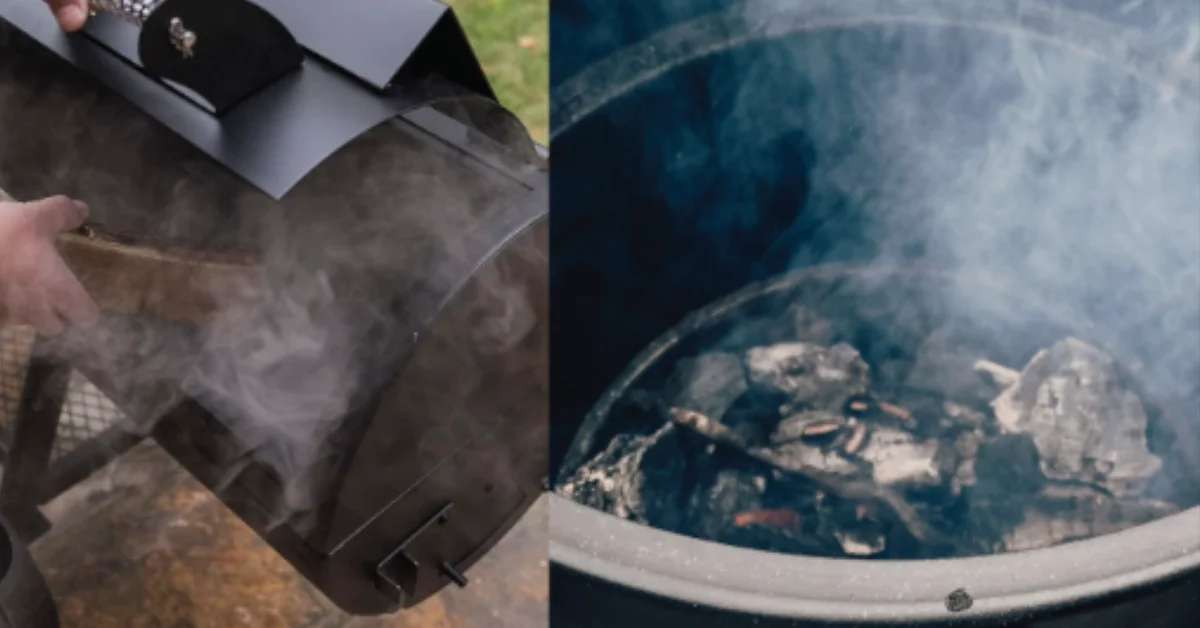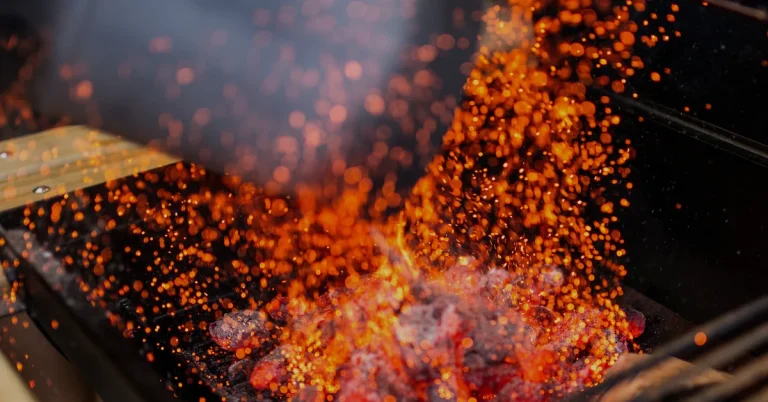Mastering Vertical Smoker Fire Management Like a Pro

Vertical smoking Fire management is the art of controlling heat to create a delicious barbecue. Mastering the art of smoking requires mastery of fire control, especially in vertical smoking. Keeping the heat low and steady for hours is crucial to that perfect, delicate BBQ. But don’t worry; Even beginners can learn chords. This guide will only focus on mastering vertical smoking fire management.
We’ll explain the conditions in easy steps, from understanding airflow to fuel selection. So, whether you’re a seasoned pitmaster or a backyard enthusiast, get ready to improve your smoking experience.
Preparing Your Vertical Smoker
The first and most crucial thing is to prepare a vertical smoker. Here is the step-by-step guide about how it is possible:
Step 1: Cleanliness of Smoker
Keeping your smoker clean is critical to cooking delicious food and maintaining a consistent temperature. Before diving into your next barbecue adventure, take some time to give your smoker a good cleaning.
This ensures that any leftover residue from previous cooking sessions is removed. A clean smoker enhances the flavor of your food and helps maintain a consistent temperature while you cook.
Here is How To Clean A Smoker:
- Gather cleaning supplies: inflexible brush and warm, soapy water.
- Remove ash and debris from the interior.
- Clean grates, walls, and racks with soapy water.
- Clean vents and chimneys to ensure proper airflow.
- Clean exterior surfaces with warm, soapy water.
Once everything is clean, rinse the smoker thoroughly with water and let it air dry completely before using it again.
Step 2: Preheat the Smoker
It’s important to preheat your smoker, like preheating the oven before baking cookies. It helps keep the temperature constant while you cook so that your food comes out just right.
Set your smoker to the temperature you want to cook, then give it some time to heat up. That way, when you add your food, the smoker is already at the right temperature, and your food cooks evenly.
So, preheat your smoker before you start cooking for best results.
Step 3: Water Pan Placement
Water pan placement is necessary for vertical smokers. It does two major things: keep the temperature stable and add moisture to the juicy meat. Before cooking, fill the water pan with hot water and place it inside the smoker.
This simple step helps cook your food properly and prevents the meat from drying out. So, when you fire up your smoker, remember the water pan. The little things make a big difference in your barbecue adventure.
Building the Fire
Step 1: Choose Your Fuel
When it comes to cooking, the fuel you use can change the taste of your food. Charcoal is popular because it provides consistent heat that cooks food evenly. But if you want to add a special smoky flavor to your food, use wood chips or chips instead.
Different types of wood can give your food different flavors, so experiment and find out which one you like best. Whether you stick with charcoal for reliability or switch it up with wood for added flavor, your fuel choice can make your food taste better.
Step 2: Lighting the Fire
Lighting the fire is another crucial step. Instead of lighter fluid, which can make your food weird, try using a fireplace starter, an electric starter for charcoal, or a small, controlled fire for wood. These methods help avoid odd flavors and keep your fire running safely.
Whether you’re cooking with charcoal or wood, how you light the fire sets the stage for a delicious meal. So, skip the lighter fluid and choose a method that makes your food taste better.
Step 3: Adding Wood Chips
Adding wood chips to your smoker can enhance the flavor of your food. Before using them, absorb the wood chips in water for about 30 minutes. This step helps them burn slowly, leaving a flavorful smoke instead of burning too quickly. Soaking the chips slowly smokes them, adding a delicious aroma to your barbecue or grilled dishes.
Remember, the key is letting the wood chips slowly release their flavors as you cook, adding an extra smokiness to your culinary creations. So, the next time you fire up the smoker, prepare your wood chips for maximum flavor infusion.
Step 4: Maintaining Temperature
To keep your smoker running smoothly, focus on maintaining the right temperature in the 150°F to 350°F range. Think of it like steering an airplane while keeping an eye on the temperature gauge and adjusting the air passages. It’s all about consistency. If it’s getting too hot, open the vents a little to let some heat out. If it’s too cold, push those vents to let in more air.
Small tweaks can make a big difference in how your food turns out. So, be vigilant and keep that temperature steady for delicious results every time you smoke.
Managing the Fire Throughout the Cook
Step 1: Adding Fuel
You should add more fuel to the fire while cooking. Check how much fuel is left and add more to keep the fire strong and the heat steady. This makes sure that your food is cooked just right. Keep an eye on the flames and make sure they stay lit.
When they start to fade, it’s time to add more fuel. Adding fuel at the right time will keep your cooking adventures running smoothly and your food tastier.
Step 2: Monitoring Smoke Color
It is very important to check the color of the smoke while cooking. Picture thin, blue smoke as your goal. It means your fire is burning clean, and your food will taste great. However, if the smoke is thick and white, watch out. This type of smoke can make your food taste bitter and unpleasant.
So, when you see smoke coming from your grill or smoker, remember: blue is good, white is bad. By keeping an eye on the color of the smoke, you can ensure that your barbecue delights your taste buds every time.
Step 3: Adjusting Air Vents
Air vents control the flow of air in a vertical smoker. The intake vent can be almost closed to fully open, while the exhaust vent is usually partially open. It is not safe to close the exhaust vent completely. Adjust them based on your smoker, weather, and fuel.
Additional Tips
- Too Hot: When your smoker gets too hot, here’s what you can do: First, use less fuel or open the vents to cool it down. If that doesn’t work, try putting something heat-resistant between the fire and where you’re cooking. These tricks can help control the heat and prevent your food from burning.
- Too Cold: If your smoker is too cold, it needs more fuel and better airflow. Don’t keep opening the door, as it spoils the temperature. Add more fuel, let the airflow, and keep the door closed for better smoking.
- Uneven Heat: When cooking, sometimes the heat is not evenly distributed across the grill or pan. To fix this, try turning your food occasionally while it cooks. Also, putting a water dish on the heat can help the temperature.
Final Thoughts
Mastering vertical smoker fire management is about detailing and understanding the key elements of controlling heat and smoke. By following simple steps like cleaning your smoker, preheating it, choosing the right fuel, and maintaining the temperature, you can create delicious barbecue every time.
Monitoring the smoke’s color and adjusting the air holes ensures that your food gets the perfect smoky flavor without bitterness. Keep in mind that practice makes perfect, so don’t be afraid to test with different techniques and fuel options to find what works best.
With patience and practice, you’ll soon become an expert at vertical smoking fire management. Your delicious barbecue creations will impress your friends and family for years. So, fire up your smoker and enjoy the delicious rewards of your smoking adventure.

I’m responsible for managing and coordinating content creation, distribution, and optimization. I’m the former editor-in-chief of PMQ Pizza Magazine and have written for several B2B food publications over the years, including Restaurant Hospitality, Flavor & The Menu, Restaurant Business, National Culinary Review, FSR, Restaurant Startup & Growth, and more.






